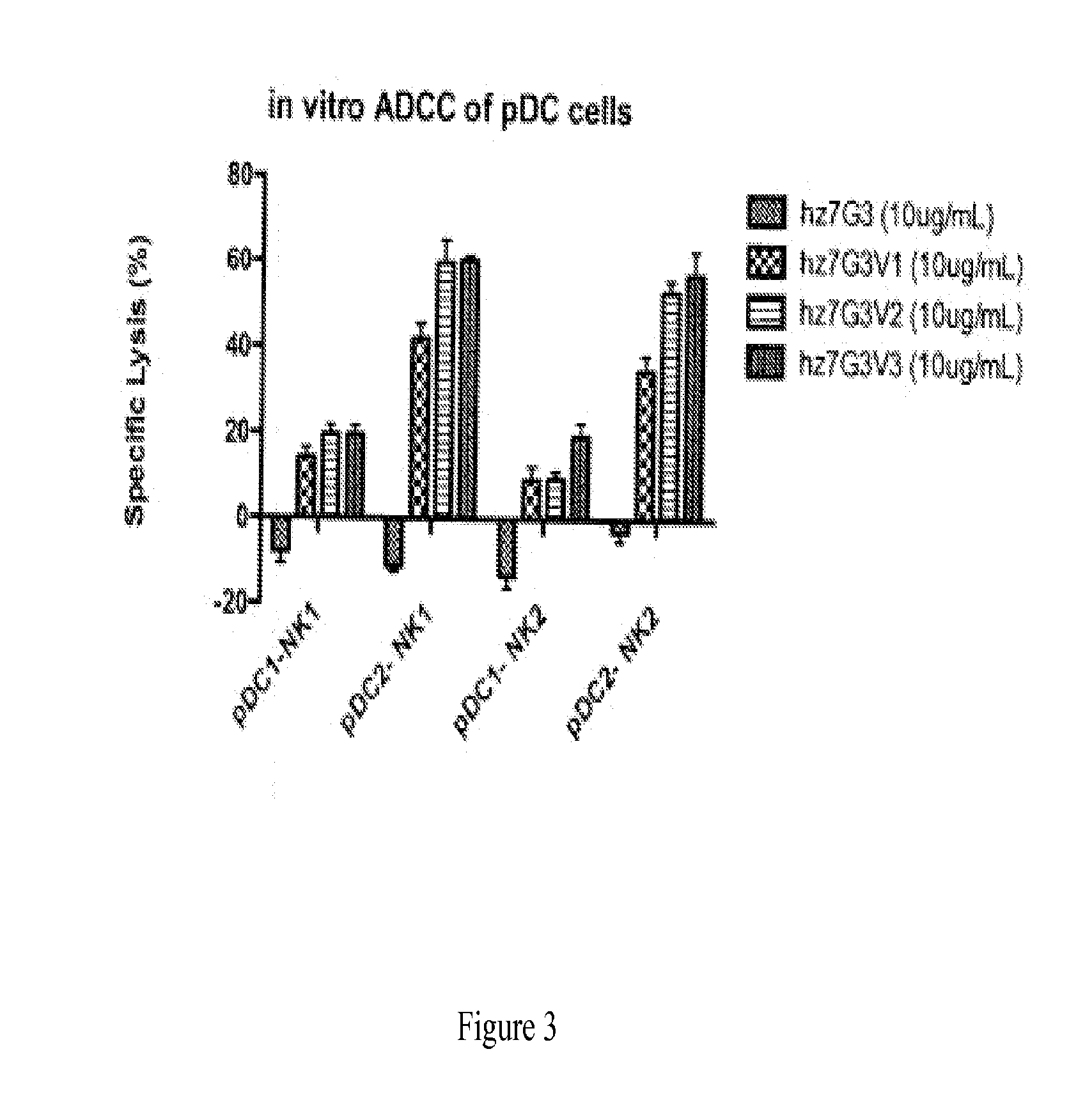Compositions and methods for targeting type 1 interferon producing cells
a technology of type 1 interferon and producing cells, applied in the field of inflammatory diseases, can solve the problems that immunoglobulins that only neutralize il-3 signaling were unlikely to sufficiently reduce ifn levels, and achieve the effects of reducing or preventing the activity of il-3, depleting or eliminating il-3 responsive cells, and sufficient specificity
- Summary
- Abstract
- Description
- Claims
- Application Information
AI Technical Summary
Benefits of technology
Problems solved by technology
Method used
Image
Examples
example 1
Expression of IL-3Rα
[0303]PBMC were identified from humans using standard techniques and various cell lineages isolated using antibodies that bind to lineage specific cell surface markers. Using Quantibrite™ beads (BD Biosciences) the number of IL-3Rα molecules per cell was determined for each lineage. As shown in FIG. 1, IL-3Rα is expressed highly on pDCs and basophils and at low levels on other cell lineages tested. This limited expression pattern makes IL-3Rα a useful target for an antibody designed to selectively eliminate pDCs and basophils.
example 2
Anti-IL-3Rα mAb Depletion of Human pDCs In Vitro
[0304]Peripheral blood mononuclear cells (PBMC) were isolated from a normal donor by Ficoll™ separation and incubated at 37° C. for various times in RPMI / 10% FCS without antibody (no antibody), with 10 μg / ml anti-ch7G3 or with 10 μg / ml antihz7G3V3. 1×106 cells were routinely cultured in a 200 μL volume in a 96 well U-bottom plate. Analysis of plasmacytoid dendritic cell (pDCs) numbers and basophil numbers was determined by flow cytometry (Tables 1 and 2, respectively). Human pDCs were identified by flow cytometry as being lineage marker negative (CD20−, CD3−, CD14−, CD19− CD56−), HLA-DR positive, CD11c negative and IL-3Rα positive (see gated box in flow diagrams). Human basophils were identified by flow cytometry as being lineage marker negative (CD20−, CD3−, CD14−, CD19− CD56−), IgE positive and IL-3Rα positive. The anti-IL-3Rα antibody containing modifications in the Fc-domain (hz7G3V3) depleted pDCs and basophils from PBMC as early ...
example 3
In Vivo Anti-IL-3Rα Depletion of pDCs and Basophils in Non-Human Primates
[0305]A non-GLP cynomolgous non-human primate (NHP) study was conducted at the Australian National Primate Facility in accordance with their standard operating procedures. All protocols and amendments were approved by the Institutional Animal Care and Use Committee. Naive monkeys were administered a single dose of neutralizing anti-IL-3Rα antibodies with modifications in the Fc-domain that enhanced antibody effector function (hz7G3V3) via intravenous infusion. Peripheral blood was collected at various time points and analysis of NHP basophils and pDCs perfumed by flow cytometry. NHP basophils were identified by flow cytometry as being IgE+ / CD123 positive. pDCs were identified by flow cytometry as being lineage marker negative (CD20−, CD3−, CD14−, CD19−, CD56−), HLA-DR positive, CD11c negative and IL-3Rα positive.
[0306]Administration of hz7G3V3 resulted in considerable reduction in the number of basophils and pD...
PUM
| Property | Measurement | Unit |
|---|---|---|
| concentration | aaaaa | aaaaa |
| concentration | aaaaa | aaaaa |
| concentration | aaaaa | aaaaa |
Abstract
Description
Claims
Application Information
 Login to View More
Login to View More - R&D
- Intellectual Property
- Life Sciences
- Materials
- Tech Scout
- Unparalleled Data Quality
- Higher Quality Content
- 60% Fewer Hallucinations
Browse by: Latest US Patents, China's latest patents, Technical Efficacy Thesaurus, Application Domain, Technology Topic, Popular Technical Reports.
© 2025 PatSnap. All rights reserved.Legal|Privacy policy|Modern Slavery Act Transparency Statement|Sitemap|About US| Contact US: help@patsnap.com



